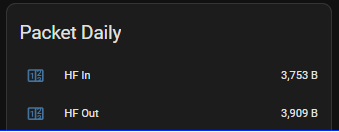This is an old revision of the document!
Table of Contents
Monitoring LinBPQ through SNMP
Enable SNMP on LinBPQ
N.B. This approach requires a recent version of LinBPQ, 6.0.24.34 or later. Older releases supported SNMP through the IPGATEWAY feature - see snmp_graphs
In the config for your telnet port, look for the existing TCPPORT block and add and extra line SNMPPORT=161, something like this:
TCPPORT=8010 FBBPORT=8011 HTTPPORT=8008 SNMPPORT=161 LOGINPROMPT=user:
Restart BPQ to enable. LinBPQ supports the following OIDs:
IfINOctets = 1.3.6.1.2.1.2.2.1.10.<port> IfOUTOctets = 1.3.6.1.2.1.2.2.1.16.<port> SysUpTime = 1.3.6.1.2.1.1.3.0 SysName = 1.3.6.1.2.1.1.5.0
If you have snmp installed locally you should be able to see data imediately:
$ snmpget -r5 -Oqv -v1 -c public localhost 1.3.6.1.2.1.2.2.1.10.2 79322
Set up monitoring in Home Assistant
One way to monitor BPQ's SNMP metrics is using Home Assistant.
SNMP support is built-in to HA but requires hand-editing configuration.yaml. If you are not comfortable doing that, stop now!
Add a sensor for each port you are interested in and restart HA to enable them:
sensor:
- platform: snmp
accept_errors: true
unit_of_measurement: "B"
state_class: total_increasing
icon: mdi:cloud-download
name: "Packet Port 1 Octets In"
unique_id: sensor.snmp_packet_port_1_octets_in
host: 192.168.1.14
baseoid: 1.3.6.1.2.1.2.2.1.10.1
- platform: snmp
accept_errors: true
unit_of_measurement: "B"
state_class: total_increasing
icon: mdi:cloud-upload
name: "Packet Port 1 Octets Out"
unique_id: sensor.snmp_packet_port_1_octets_out
host: 192.168.1.14
baseoid: 1.3.6.1.2.1.2.2.1.16.1
2.1 Traffic Graphs
I use the Statistics Graph Card to monitor traffic in and out on each port:
Or if you prefer, here's the card configuration:
chart_type: line period: 5minute type: statistics-graph entities: - sensor.packet_port_1_octets_in_2 - sensor.packet_port_1_octets_out_2 days_to_show: 1 title: Port 1 stat_types: - change hide_legend: true
2.2 Daily Counters
I have set up counters for each port:

Go to Settings, Helpers, Create Helper and choose Utility Meter. Get this right first go as you don't seem to be able to go back and edit all the features - in particular the reset cycle…
2.3 CPU Temperature
I may have got carried away with monitoring (and Pi's…) but you can also add an OID for CPU temperature to each of your Pi's - see this article.
The SNMP setup in HA is similar to before, but the temperature returned is is actually in milli-centigrade (if that's a unit!) so I added a Template Sensor to get actual °C:
sensor:
- platform: snmp
accept_errors: true
unit_of_measurement: "°C"
device_class: temperature
state_class: measurement
icon: mdi:thermometer
name: "CPU Temp - SNMP - Pi-Radio"
unique_id: sensor.snmp_cpu_temp_pi_radio
host: 192.168.99.14
port: 8161
baseoid: 1.3.6.1.2.1.25.1.8
template:
- sensor:
- name: "Pi-Radio CPU"
unique_id: sensor.cpu_temp_pi_radio
state: "{{ (states('sensor.cpu_temp_pi_radio_2') | float() / 1000) | round(1) }}"
unit_of_measurement: "°C"
icon: mdi:thermometer
state_class: measurement
device_class: temperature
Telegraf / Grafana
Another way to collect and monitor BPQ's SNMP metrics is by using Telegraf. You typically run Telegraf as part of a monitoring stack, in this case Telegraf + InfluxDB + Grafana.
In telegraf.conf:
[[inputs.snmp]] agents = ["udp4://localhost:161"] version = 1 # for each port... [[inputs.snmp.field]] oid = "1.3.6.1.2.1.2.2.1.10.1" name = "port_1_octets_in" conversion = "int" [[inputs.snmp.field]] oid = "1.3.6.1.2.1.2.2.1.16.1" name = "port_1_octets_out" conversion = "int"
These counters show up in InfluxDB under a measurement named SNMP with multiple fields, one for each oid.
Query like this:
End result:





